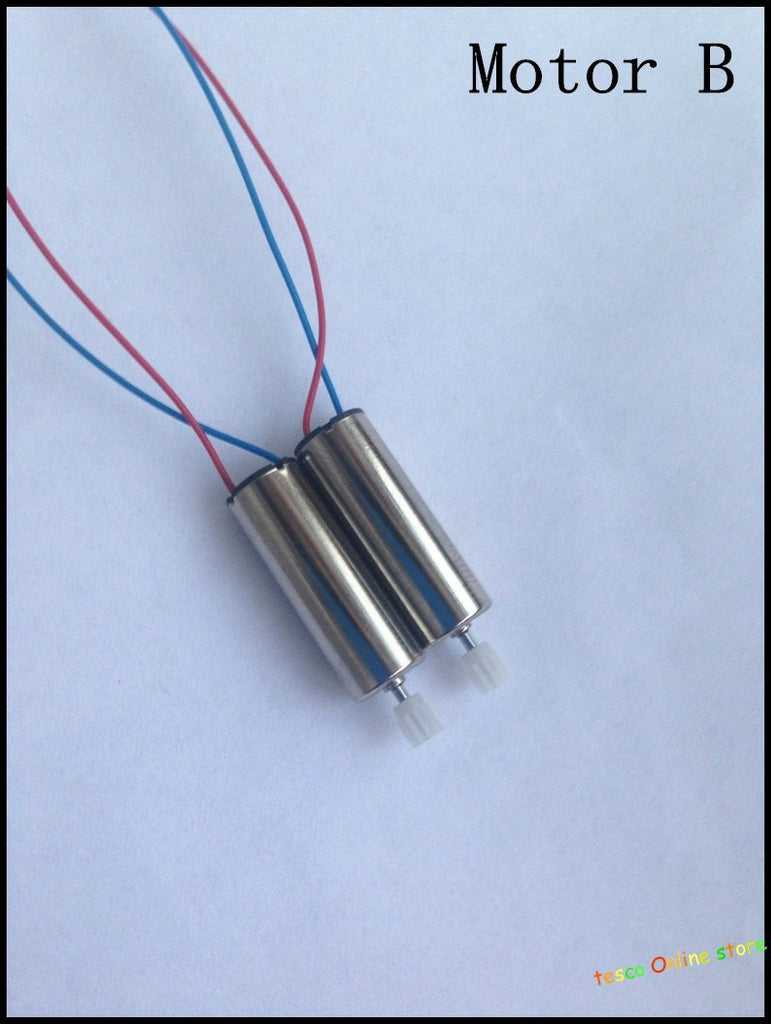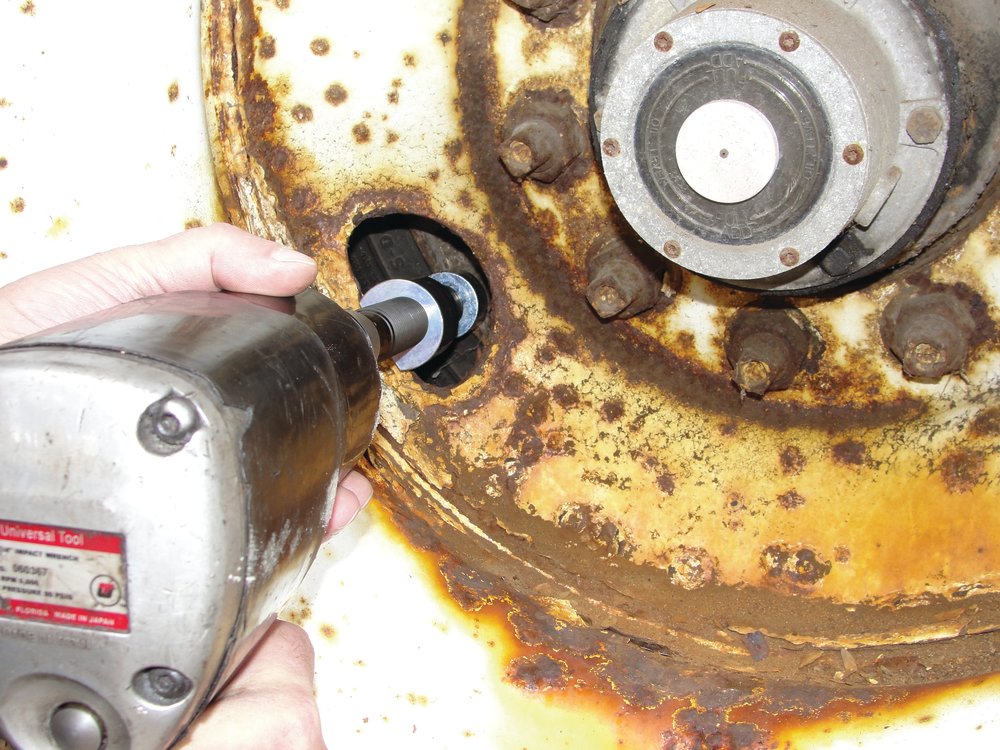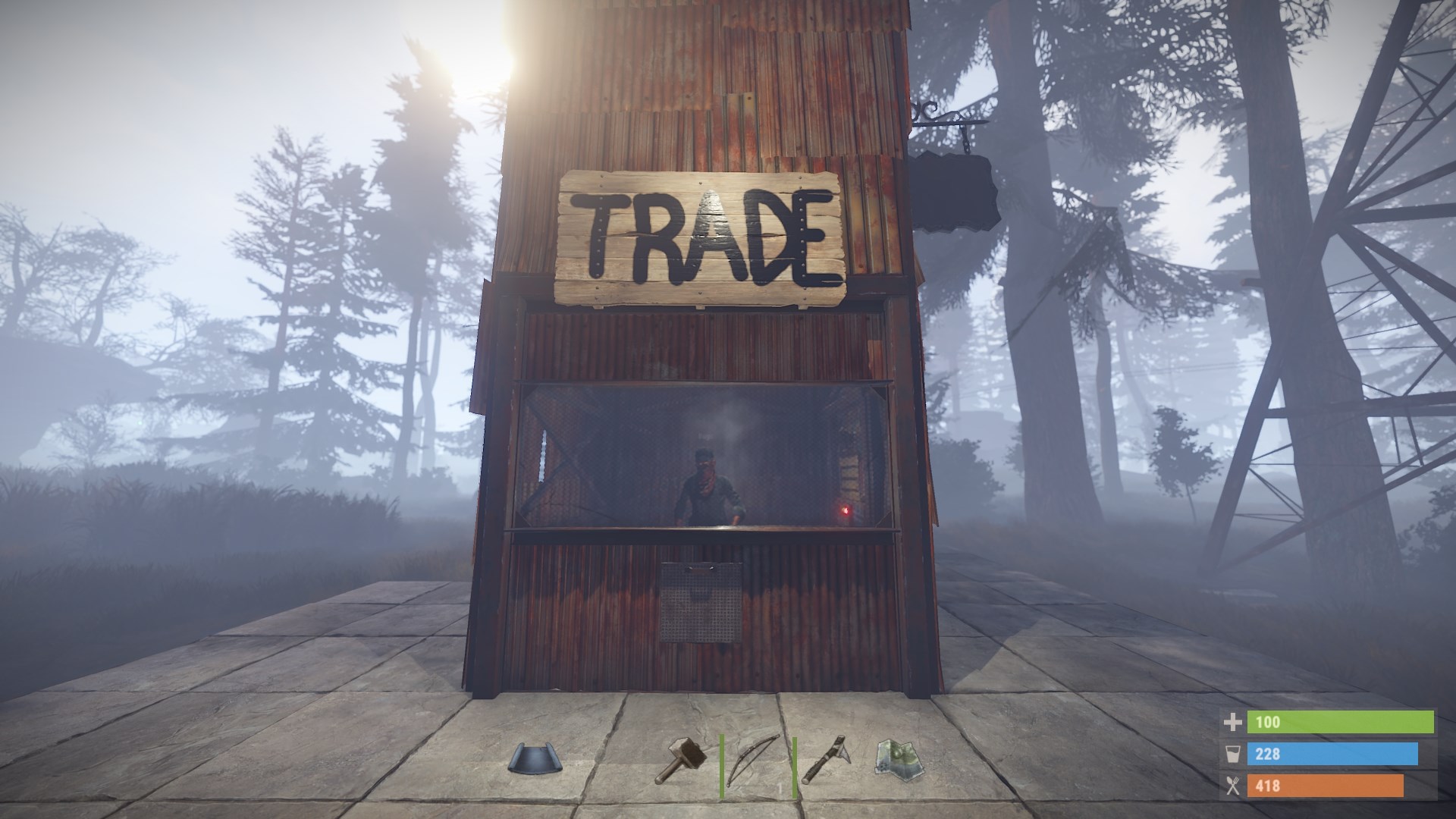Corrosion is the degradation of a metal caused by an electrochemical process. Large sums of money are spent each year repairing the effects of, or preventing, corrosion. Some metals, such as aluminum and copper, produce a protective layer when they corrode in air. The rust that forms on iron metal flakes off, exposing fresh metal, which also corrodes. One way to prevent, or slow, corrosion is by coating the metal.
Coating prevents water and oxygen from contacting the metal. Paint or other coatings will slow corrosion, but they are not effective once scratched. Zinc-plated or galvanized iron exploits the fact that zinc is more likely to oxidize than iron. As long as the coating remains, even if scratched, the zinc will oxidize before the iron.
Another method for protecting metals is cathodic protection. In this method, an easily oxidized and inexpensive metal, often zinc or magnesium , is electrically connected to the metal that must be protected. The more active metal is the sacrificial anode, and is the anode in a galvanic cell. The "protected" metal is the cathode, and remains unoxidized.
One advantage of cathodic protection is that the sacrificial anode can be monitored and replaced if needed. Galvanized steel is technically a coated material, but it is worth mentioning here. Galvanized steel is a carbon steel that would most likely rust if it did not have one or more layers of zinc applied to it. The zinc layer acts as a sacrificial metal for the steel. This means that the zinc layer will combine with the oxygen more readily than the iron in the steel will. This creates a zinc oxide layer that prevents the formation of iron oxide, thus eliminating the possibility of rust forming.
However, if the zinc coating is damaged, or if the galvanized steel is placed in extreme environments, the zinc coating may be rendered ineffective and the steel will rust. Galvanized steel is also susceptible to "white rust" which is a type of corrosion that forms under specific conditions, typically involving water or condensation. The formation of white rust does not necessarily damage the material or the zinc coating. Instead, iron corrosion results in a reddish-brown, flaky, powdery substance called rust, which does not act as a stable barrier of protection against further corrosion. Steel will rust immediately when being exposed to moisture and air.
While the chemical reaction that causes steel to corode happens instantly, it may take some time for you to notice. Visual signs of rust may appear as quickly as a week or two when exposed to the right conditions. Rusting will affect the exterior of steel first before slowly corroding through the steel surface.
Given enough time, all iron in the steel material will oxidize and render the steel essentially useless for the purpose it was intended for. Luckily, that oxidation process typically takes a long time, and some rusted surfaces can be fixed with a little bit of work as Jay Leno helps to explain. The presence of the stable film prevents additional corrosion by acting as a barrier that limits oxygen and water access to the underlying metal surface. Because the film forms so readily and tightly, even only a few atomic layers reduce the rate of corrosion to very low levels. The fact that the film is much thinner than the wavelength of light makes it difficult to see without the aid of modern instruments.
Thus, although the steel is corroded on the atomic level, it appears stainless. As such, this film, otherwise known as rust, achieves sufficient thickness to make it easily observable soon after exposure to water and air. It occurs when iron combines with the oxygen in the air causing it to corrode.
Rust is the orange-brown discoloration that builds up on metal. Rust can affect iron and its alloys, including steel. Whenever you have iron, water and oxygen together, you get rust. Although iron and steel structures seem solid to the eye, water molecules are able to penetrate microscopic gaps in the metal. If salt is present, for example in seawater, the corrosion will be more rapid. Exposure to sulfur dioxide and carbon dioxide will also hasten the corrosive process.
When iron is in contact with water and oxygen, it rusts. If salt is present, for example in seawater or salt spray, the iron tends to rust more quickly, as a result of chemical reactions. Iron metal is relatively unaffected by pure water or by dry oxygen.
As with other metals, like aluminium, a tightly adhering oxide coating, a passivation layer, protects the bulk iron from further oxidation. The conversion of the passivating ferrous oxide layer to rust results from the combined action of two agents, usually oxygen and water. When any type of steel rusts, including steel, it undergoes a chemical reaction called corrosion.
Rust only forms on the outside of a metal surface because it requires exposure of oxygen and water to rust. I've had this Maine 'buoy bell' wind chime for about eight years now. It has the haunting melancholy sound of a bell buoy at sea being tossed by wind and waves. It is made of COR-TEN steel which is designed to rust on the surface to create a protective barrier against further rusting.
It came painted black on the outside and was supposed to develop this rich rust patina naturally over time. Seeing it was taking so long, I decided to take things into my own hands and, ah, "help" mother nature along and accelerate the process. I searched the net and found mostly dangerous methods to induce rust on steel using highly caustic or acidic chemical solutions. However I finally did find a simple safe method, using on-hand household chemicals, buried deep within a thread on the subject at a metalworking forum. I got spectacular results which have not only withstood the wind and rain of the southwest but have actually improved with the help of mother nature. Over time, the oxygen combines with the metal forming new compounds collectively called rust.
The best-known of these reactions involve oxygen, hence the name "oxidation". The terms "rust" and "rusting" only mean oxidation of iron and its resulting products. Many other oxidation reactions exist which do not involve iron or produce rust. But only iron or alloys that contain iron can rust. However, other metals can corrode in similar ways.
Given sufficient time, any iron mass, in the presence of water and oxygen, could eventually convert entirely to rust. Surface rust is commonly flaky and friable, and provides no passivational protection to the underlying iron, unlike the formation of patina on copper surfaces. Rusting is the common term for corrosion of elemental iron and its alloys such as steel. Many other metals undergo similar corrosion, but the resulting oxides are not commonly called "rust". Corrosion is an electrochemical reaction that appears in several forms, such as chemical corrosion and atmospheric corrosion, the latter of which is the most common form. When acidic substances come in contact with metals, such as iron and/or steel, rust begins to form.
Rust is the result of corroding steel after the iron particles have been exposed to oxygen and moisture (e.g., humidity, vapor, immersion). When steel is exposed to water, the iron particles are lost to the water's acidic electrolytes. The iron particles then become oxidized, which results in the formation of Fe⁺⁺. When Fe⁺⁺ is formed, two electrons are released and flow through the steel to another area of the steel known as the cathodic area. When metal parts are properly stored with VCI Packaging products, VCIs activate and fill up the vapor space inside the packaging.
The VCI ions form a shield of protection on the surface of metal that displaces moisture and eradicates rust. VCI Packaging safely prevents corrosion on protected metals without the need for messy grease, oils, protective coatings or other time-consuming methods. If steel wool and carbon steel coupons are not available to show the transfer of rust and iron staining of paper, then try a few common nails instead. Clean the nails with sandpaper to ensure there is no oil or protective coating to interfere with rusting.
Tightly wrap the nails in wet paper towel, and allow the paper towel to air dry. Squeeze out excess liquid from the paper towel before wrapping the nails, and then squeeze the paper towel around the nails to provide good contact. Austenitic stainless steels such as 304 or 316 have high amounts of nickel and chromium. The chromium combines with the oxygen before the iron is able to which forms a chromium oxide layer. This layer is very corrosion resistant which prevents rust formation and protects the underlying metal.
Stainless steel is another example of a metal that does not rust. Through it is important to note that some grades are more resistant to rust than others. On the other hand, ferritic or martensitic stainless steels may be susceptible to rust because they contain less chromium. The corrosion rate of low carbon steel increases due to industrial pollutants, ambient humidity and marine environments. Concrete corrosion is often minimized by implementing a cathodic protection technique. There are ways for metalworking and manufacturing companies to protect their iron workpieces from rusting.
Galvanization, for example, is a common anti-corrosion treatment process for iron. It involves the application of a protective coating over the surface of a metal workpiece. With galvanization, zinc is applied over the surface of iron. The zinc layer acts as a barrier between the iron and its surrounding environment. As a result, the iron doesn't come into contact with air or moisture. Assuming the zinc layer remains intact, galvanized iron shouldn't rust.
In some ways the easy part of corrosion prevention on stainless steel is removing the rust. The hard part is keeping the rust off without costly component redesign or re manufacture. You can keep your components and improve corrosion resistance by bonding a high tolerance, high durability, corrosion resistant coating to the surface after rust removal. Have more questions about how our coatings can prevent rust on stainless steel? Contact our Technical Service Team for a free coating consultation.
Removing surface rust from surfaces improves the appearance, but it's importance goes beyond the decorative. Set the degreased object outdoors or in a well-ventilated area on a piece of cardboard. Work in an area where you can spray rusting solution without affecting nearby surfaces. Spray your metal object with plain white vinegar, soaking the surface and letting it dry before reapplying. The acidic vinegar lightly etches the metal surface so the piece will rust faster.
How Can You Make Steel Rust Fast The fast and DIY way to rust metal on purpose is to make a mixture in a spray bottle of white vinegar, hydrogen peroxide, and salt. Spray the mixture onto the metal surface several times, letting it dry between coats and your metal will take on a rusty patina almost instantly. This is accomplished through hot-dip galvanizing or electroplating. The iron or steel object is coated in a thin layer of zinc. This stops oxygen and water reaching the metal underneath but the zinc also acts as a sacrificial metal.
Zinc is more reactive than iron, so it oxidizes in preference to the iron object. The zinc oxide layer prevents the formation of iron oxide, thus eliminating the possibility of rust forming. Several forms of rust are distinguishable both visually and by spectroscopy, and form under different circumstances. Other forms of rust include the result of reactions between iron and chloride in an environment deprived of oxygen. Rebar used in underwater concrete pillars, which generates green rust, is an example. Although rusting is generally a negative aspect of iron, a particular form of rusting, known as stable rust, causes the object to have a thin coating of rust over the top.
And if kept in low relative humidity, makes the "stable" layer protective to the iron below, but not to the extent of other oxides such as aluminium oxide on aluminium. People may also use rust inhibitors to modify an otherwise corrosive metal. Consumers may use products such as Rust-Oleum's Rusty Metal Primer and Rust Reformer to inhibit corrosion on items with preexisting iron oxide. There are plenty of other rust inhibitors used to protect items in specific environments. Some popular rust-inhibiting additives include zinc phosphate and volatile amines . MEtal can also under galvanization at the industrial level.
Galvanization is the process of coating iron and steel with zinc . Coating steel with zinc is commonly referred to as galvanizing steel. Steel, among other metals like aluminum and iron, are immersed in 860 degree Fahrenheit zinc. The zinc reacts with oxygen and carbon dioxide to form zinc carbonate, which is seen as the exterior of many metallic objects like street lamps, I-beams, and other steel products. Not only does it give the steel a nice visual appearance, it does an excellent job with preventing rust from forming.
Of course, if the exterior surface gets scratched or worn away, then the now exposed steel will begin to corrode. Stainless steel remains stainless, or does not rust, because of the interaction between its alloying elements and the environment. Stainless steel contains iron, chromium, manganese, silicon, carbon and, in many cases, significant amounts of nickel and molybdenum.
These elements react with oxygen from water and air to form a very thin, stable film that consists of such corrosion products as metal oxides and hydroxides. Chromium plays a dominant role in reacting with oxygen to form this corrosion product film. In fact, all stainless steels by definition contain at least 10 percent chromium.
Degrease the stripped metal with a commercial degreaser to remove grime, dirt or remnants of finish that will prevent the chemical reaction that causes rust. Wear protective goggles and gloves every time you handle chemicals during the rust patina process. Do not handle a degreased piece of metal with your bare hands, to avoid any skin oil residue, which repels the rusting solution. The term stainless steel is a reference to the alloy's tendency to resist rust under normal conditions. Over time, especially outdoors, high humidity or rain will cause the iron to undergo flash rusting and result in ugly rust stains. Similarly, grinding wheels used on iron should not be used later on other metals, because bits of iron can be transferred to the other metals.
Any grinding of iron should be done well away from other metals, so that any iron ejected from the grinding wheel does not land on the other metals. Some chemical reactions in which bacteria participate are harmful rather than helpful to industry. Bacteria are major agents of metal corrosion through the formation of rust, especially on metals containing iron. During the early stages of rust formation, hydrogen is produced, and it acts to slow the rusting process. However, certain bacteria use the hydrogen as a nutrient with the result that they greatly speed up rust formation.

























No comments:
Post a Comment
Note: Only a member of this blog may post a comment.